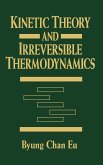Michel Soustelle
Chemical Equilibria
Michel Soustelle
Chemical Equilibria
- Gebundenes Buch
- Merkliste
- Auf die Merkliste
- Bewerten Bewerten
- Teilen
- Produkt teilen
- Produkterinnerung
- Produkterinnerung
The book offers advanced students, in 7 volumes, successively characterization tools phases, the study of all types of phase, liquid, gas and solid, pure or multi-component, process engineering, chemical and electrochemical equilibria, the properties of surfaces and phases of small sizes. Macroscopic and microscopic models are in turn covered with a constant correlation between the two scales. Particular attention was given to the rigor of mathematical developments. Besides some very specialized books, the vast majority of existing works are intended for beginners and therefore limited in…mehr
Andere Kunden interessierten sich auch für
![Ionic and Electrochemical Equilibria Ionic and Electrochemical Equilibria]() Michel SoustelleIonic and Electrochemical Equilibria176,99 €
Michel SoustelleIonic and Electrochemical Equilibria176,99 €![Thermal Physics: Entropy and Free Energies Thermal Physics: Entropy and Free Energies]() Joon Chang LeeThermal Physics: Entropy and Free Energies45,99 €
Joon Chang LeeThermal Physics: Entropy and Free Energies45,99 €![Thermodynamics of Surfaces and Capillary Systems Thermodynamics of Surfaces and Capillary Systems]() Michel SoustelleThermodynamics of Surfaces and Capillary Systems170,99 €
Michel SoustelleThermodynamics of Surfaces and Capillary Systems170,99 €![Chemical Thermodynamics at a Glance Chemical Thermodynamics at a Glance]() H Donald Brooke JenkinsChemical Thermodynamics at a Glance50,99 €
H Donald Brooke JenkinsChemical Thermodynamics at a Glance50,99 €![Kinetic Theory and Irreversible Thermodynamics Kinetic Theory and Irreversible Thermodynamics]() Byung Chan EuKinetic Theory and Irreversible Thermodynamics454,99 €
Byung Chan EuKinetic Theory and Irreversible Thermodynamics454,99 €![Chemical Thermodynamics Chemical Thermodynamics]() Peter A RockChemical Thermodynamics90,99 €
Peter A RockChemical Thermodynamics90,99 €![Advances in Chemical Physics, Volume 91 Advances in Chemical Physics, Volume 91]() Advances in Chemical Physics, Volume 91519,99 €
Advances in Chemical Physics, Volume 91519,99 €-
-
-
The book offers advanced students, in 7 volumes, successively characterization tools phases, the study of all types of phase, liquid, gas and solid, pure or multi-component, process engineering, chemical and electrochemical equilibria, the properties of surfaces and phases of small sizes. Macroscopic and microscopic models are in turn covered with a constant correlation between the two scales. Particular attention was given to the rigor of mathematical developments. Besides some very specialized books, the vast majority of existing works are intended for beginners and therefore limited in scope. There is no obvious connection between the two categories of books, general books does not go far enough in generalizing concepts to enable easy reading of advanced literature. The proposed project aims to give readers the ability to read highly specialized publications based on a more general presentation of the different fields of chemical thermodynamics. Consistency is ensured between the basic concepts and applications. So we find, in the same work, the tools, their use and comparison, for a more general macroscopic description and a microscopic description of a phase.
Hinweis: Dieser Artikel kann nur an eine deutsche Lieferadresse ausgeliefert werden.
Hinweis: Dieser Artikel kann nur an eine deutsche Lieferadresse ausgeliefert werden.
Produktdetails
- Produktdetails
- Verlag: Wiley
- Seitenzahl: 224
- Erscheinungstermin: 26. Oktober 2015
- Englisch
- Abmessung: 240mm x 161mm x 16mm
- Gewicht: 489g
- ISBN-13: 9781848218673
- ISBN-10: 1848218672
- Artikelnr.: 43032835
- Herstellerkennzeichnung
- Libri GmbH
- Europaallee 1
- 36244 Bad Hersfeld
- gpsr@libri.de
- Verlag: Wiley
- Seitenzahl: 224
- Erscheinungstermin: 26. Oktober 2015
- Englisch
- Abmessung: 240mm x 161mm x 16mm
- Gewicht: 489g
- ISBN-13: 9781848218673
- ISBN-10: 1848218672
- Artikelnr.: 43032835
- Herstellerkennzeichnung
- Libri GmbH
- Europaallee 1
- 36244 Bad Hersfeld
- gpsr@libri.de
Michel SOUSTELLE is a chemical engineer and Emeritus Professor at Ecole des Mines de Saint-Etienne in France. He taught chemical kinetics from postgraduate to Master degree level while also carrying out research in this topic.
Preface xi
Notations and Symbols xv
Chapter 1 Physico-Chemical Transformations and Equilibria 1
1.1 Characteristic parameters of physico-chemical transformations 1
1.1.1 Balance equation of a transformation 1
1.1.2 Values associated with a transformation 2
1.1.3 Standard values associated with a transformation 3
1.1.4 Extent and rate of a transformation 3
1.2 Entropy production during the course of a transformation in a closed
system 4
1.3 Affinity of a transformation 5
1.3.1 Definition 5
1.3.2 Affinity and characteristic functions 6
1.3.3 Affinity and chemical potentials 7
1.3.4 Affinity, reaction quotient and activities 8
1.3.5 Total differential of the affinity in variables Yl, Xm , ¿ 9
1.3.6 Derivatives of the affinity in relation to the extent and the
chemical potentials 11
1.4 De Donder's inequality - direction of the transformations and
equilibrium conditions 12
1.5 Heats of transformation 14
1.5.1 Heat of transformation at constant pressure and temperature 15
1.5.2 Heat of transformation at constant volume and temperature 16
1.5.3 Variations in the heat of transformation at constant pressure with
changing temperature - Kirchhoff relation 17
1.6 Set of points representing the equilibrium states of a transformation
18
1.7 Closed systems accommodating multiple reactions 19
1.8 Direction of evolution and equilibrium conditions in an open system 20
1.9 Azeotropic transformations 21
Chapter 2 Properties of States of Physico-Chemical Equilibrium 25
2.1 Laws of displacement of an equilibrium 25
2.1.1 General form of the displacement laws 25
2.1.2 Influence of a temperature disturbance 26
2.1.3 Influence of a pressure disturbance 27
2.1.4 Influence of the addition of a component 27
2.1.5 Influence of the addition of an inert component 32
2.2 Properties of all the equilibria in a system 33
2.2.1 Property of the set of balance equations of a system 34
2.2.2 Linear combinations of balance equations 36
2.2.3 Base of the vector space of the balance equations - Jouguet criteria
37
2.3 Phase laws 41
2.3.1 Reminder of Gibbs' phase rule 41
2.3.2 Duhem's phase rule in closed systems 42
2.3.3 Comparison between the Gibbs variance and the Duhem variance 44
2.4 Indifferent states 44
2.4.1 Definition 45
2.4.2 Condition of indifference of a state 45
2.4.3 Set of indifferent points of equilibrium 47
2.4.4 Gibbs-Konovalov theorem 47
2.5 Thermodynamically-equivalent systems 48
2.6 Stability of equilibria 48
2.6.1 De Donder's general stability condition 49
2.6.2 Stability of a system with unilateral variations 49
2.6.3 Stability of a system with bilateral variations 51
2.6.4 Conditions of bilateral stability expressed in terms of chemical
potentials 53
Chapter 3 Molecular Chemical Equilibria 55
3.1 Law of mass action - equilibrium constants 55
3.1.1 Expression of the law of mass action 55
3.1.2 Different forms of the law of mass action 57
3.1.3 Use of solution models and application of the law of mass action 62
3.1.4 Systems composed of a set of equilibria 63
3.1.5 Unit of the equilibrium constants 64
3.1.6 Variations of the equilibrium constants with temperature 64
3.1.7 Influence of the choice of reference pressure on the equilibrium
constant 66
3.1.8 Dissociative dissolution of a gas in a solid 67
3.2 Graphical representations of equilibria - pole diagrams 69
3.2.1 Principle of the pole diagram 69
3.2.2 Influence of a temperature change on a pole diagram 70
3.2.3 Pole diagrams of two reactions in the same family 72
3.3 Representation of the evolution of an equilibrium with the temperature
73
3.3.1 Diagram in van 't Hoff coordinates 73
3.3.2 Ellingham diagrams 74
3.4 Binary diagrams for chemical equilibrium 88
3.5 Ternary diagrams of chemical equilibria 89
3.5.1 Mode of representation 90
3.5.2 Molar fractions at equilibrium and initial composition 93
3.5.3 Iso-Q curves in perfect solutions 95
3.5.4 Iso-composition curves in perfect solutions 98
3.6 Quaternary diagrams of chemical equilibria 100
Chapter 4 Determination of the Values Associated with Reactions -
Equilibrium Calculations 105
4.1 Reminders of a few thermodynamic relations 105
4.2 Enthalpies of reaction - thermochemistry 110
4.2.1 Experimental determination of the reaction enthalpies by calorimetry
111
4.2.2 Calculation of the standard enthalpy at another temperature 111
4.2.3 Influence of the pressure on the reaction enthalpies 111
4.2.4 Determination of the reaction enthalpies by calculation on the basis
of other thermodynamic data 112
4.2.5 Enthalpies of formation 114
4.2.6 Enthalpies of combustion 116
4.2.7 Dissociation energy, bond energy and enthalpies of formation 119
4.3 Reaction entropies 126
4.3.1 Planck's hypothesis - calculation of the calorimetric entropies 126
4.3.2 Spectroscopic determination of entropies - absolute entropies 128
4.3.3 The third law 128
4.4 Specific heat capacities 131
4.4.1 Calorimetric measurements of the specific heat capacities 131
4.4.2 Spectral measurements of the specific heat capacities 134
4.5 Experimental determination of the equilibrium constants 134
4.6 Calculation of the equilibrium constants on the basis of other
thermodynamic data 136
4.6.1 Calculation of the equilibrium constants - method 1 137
4.6.2 Calculation of the equilibrium constants - method 2 137
4.6.3 Calculation of the equilibrium constants - method 3 137
4.6.4 Calculation of the equilibrium constants - method 4 138
4.6.5 Calculation of the equilibrium constants - method 5 138
4.7 Determination of the equilibrium constants on the basis of spectral
data and statistical thermodynamics 140
4.8 Thermodynamic tables and databanks 140
4.9 Estimation of thermodynamic data 142
4.9.1 Method of evaluating the energies of dissociation by spectroscopy 143
4.9.2 Group contribution methods 143
4.10 Thermodynamic calculations for complex systems 146
4.10.1 Definition of the system 147
4.10.2 Output mode - graphical representation 147
4.10.3 Calculation method based on the equilibrium constants 148
4.10.4 Method of minimization of the Gibbs energy function 149
Appendices 151
Appendix 1 153
Appendix 2 163
Bibliography 181
Index 185
Notations and Symbols xv
Chapter 1 Physico-Chemical Transformations and Equilibria 1
1.1 Characteristic parameters of physico-chemical transformations 1
1.1.1 Balance equation of a transformation 1
1.1.2 Values associated with a transformation 2
1.1.3 Standard values associated with a transformation 3
1.1.4 Extent and rate of a transformation 3
1.2 Entropy production during the course of a transformation in a closed
system 4
1.3 Affinity of a transformation 5
1.3.1 Definition 5
1.3.2 Affinity and characteristic functions 6
1.3.3 Affinity and chemical potentials 7
1.3.4 Affinity, reaction quotient and activities 8
1.3.5 Total differential of the affinity in variables Yl, Xm , ¿ 9
1.3.6 Derivatives of the affinity in relation to the extent and the
chemical potentials 11
1.4 De Donder's inequality - direction of the transformations and
equilibrium conditions 12
1.5 Heats of transformation 14
1.5.1 Heat of transformation at constant pressure and temperature 15
1.5.2 Heat of transformation at constant volume and temperature 16
1.5.3 Variations in the heat of transformation at constant pressure with
changing temperature - Kirchhoff relation 17
1.6 Set of points representing the equilibrium states of a transformation
18
1.7 Closed systems accommodating multiple reactions 19
1.8 Direction of evolution and equilibrium conditions in an open system 20
1.9 Azeotropic transformations 21
Chapter 2 Properties of States of Physico-Chemical Equilibrium 25
2.1 Laws of displacement of an equilibrium 25
2.1.1 General form of the displacement laws 25
2.1.2 Influence of a temperature disturbance 26
2.1.3 Influence of a pressure disturbance 27
2.1.4 Influence of the addition of a component 27
2.1.5 Influence of the addition of an inert component 32
2.2 Properties of all the equilibria in a system 33
2.2.1 Property of the set of balance equations of a system 34
2.2.2 Linear combinations of balance equations 36
2.2.3 Base of the vector space of the balance equations - Jouguet criteria
37
2.3 Phase laws 41
2.3.1 Reminder of Gibbs' phase rule 41
2.3.2 Duhem's phase rule in closed systems 42
2.3.3 Comparison between the Gibbs variance and the Duhem variance 44
2.4 Indifferent states 44
2.4.1 Definition 45
2.4.2 Condition of indifference of a state 45
2.4.3 Set of indifferent points of equilibrium 47
2.4.4 Gibbs-Konovalov theorem 47
2.5 Thermodynamically-equivalent systems 48
2.6 Stability of equilibria 48
2.6.1 De Donder's general stability condition 49
2.6.2 Stability of a system with unilateral variations 49
2.6.3 Stability of a system with bilateral variations 51
2.6.4 Conditions of bilateral stability expressed in terms of chemical
potentials 53
Chapter 3 Molecular Chemical Equilibria 55
3.1 Law of mass action - equilibrium constants 55
3.1.1 Expression of the law of mass action 55
3.1.2 Different forms of the law of mass action 57
3.1.3 Use of solution models and application of the law of mass action 62
3.1.4 Systems composed of a set of equilibria 63
3.1.5 Unit of the equilibrium constants 64
3.1.6 Variations of the equilibrium constants with temperature 64
3.1.7 Influence of the choice of reference pressure on the equilibrium
constant 66
3.1.8 Dissociative dissolution of a gas in a solid 67
3.2 Graphical representations of equilibria - pole diagrams 69
3.2.1 Principle of the pole diagram 69
3.2.2 Influence of a temperature change on a pole diagram 70
3.2.3 Pole diagrams of two reactions in the same family 72
3.3 Representation of the evolution of an equilibrium with the temperature
73
3.3.1 Diagram in van 't Hoff coordinates 73
3.3.2 Ellingham diagrams 74
3.4 Binary diagrams for chemical equilibrium 88
3.5 Ternary diagrams of chemical equilibria 89
3.5.1 Mode of representation 90
3.5.2 Molar fractions at equilibrium and initial composition 93
3.5.3 Iso-Q curves in perfect solutions 95
3.5.4 Iso-composition curves in perfect solutions 98
3.6 Quaternary diagrams of chemical equilibria 100
Chapter 4 Determination of the Values Associated with Reactions -
Equilibrium Calculations 105
4.1 Reminders of a few thermodynamic relations 105
4.2 Enthalpies of reaction - thermochemistry 110
4.2.1 Experimental determination of the reaction enthalpies by calorimetry
111
4.2.2 Calculation of the standard enthalpy at another temperature 111
4.2.3 Influence of the pressure on the reaction enthalpies 111
4.2.4 Determination of the reaction enthalpies by calculation on the basis
of other thermodynamic data 112
4.2.5 Enthalpies of formation 114
4.2.6 Enthalpies of combustion 116
4.2.7 Dissociation energy, bond energy and enthalpies of formation 119
4.3 Reaction entropies 126
4.3.1 Planck's hypothesis - calculation of the calorimetric entropies 126
4.3.2 Spectroscopic determination of entropies - absolute entropies 128
4.3.3 The third law 128
4.4 Specific heat capacities 131
4.4.1 Calorimetric measurements of the specific heat capacities 131
4.4.2 Spectral measurements of the specific heat capacities 134
4.5 Experimental determination of the equilibrium constants 134
4.6 Calculation of the equilibrium constants on the basis of other
thermodynamic data 136
4.6.1 Calculation of the equilibrium constants - method 1 137
4.6.2 Calculation of the equilibrium constants - method 2 137
4.6.3 Calculation of the equilibrium constants - method 3 137
4.6.4 Calculation of the equilibrium constants - method 4 138
4.6.5 Calculation of the equilibrium constants - method 5 138
4.7 Determination of the equilibrium constants on the basis of spectral
data and statistical thermodynamics 140
4.8 Thermodynamic tables and databanks 140
4.9 Estimation of thermodynamic data 142
4.9.1 Method of evaluating the energies of dissociation by spectroscopy 143
4.9.2 Group contribution methods 143
4.10 Thermodynamic calculations for complex systems 146
4.10.1 Definition of the system 147
4.10.2 Output mode - graphical representation 147
4.10.3 Calculation method based on the equilibrium constants 148
4.10.4 Method of minimization of the Gibbs energy function 149
Appendices 151
Appendix 1 153
Appendix 2 163
Bibliography 181
Index 185
Preface xi
Notations and Symbols xv
Chapter 1 Physico-Chemical Transformations and Equilibria 1
1.1 Characteristic parameters of physico-chemical transformations 1
1.1.1 Balance equation of a transformation 1
1.1.2 Values associated with a transformation 2
1.1.3 Standard values associated with a transformation 3
1.1.4 Extent and rate of a transformation 3
1.2 Entropy production during the course of a transformation in a closed
system 4
1.3 Affinity of a transformation 5
1.3.1 Definition 5
1.3.2 Affinity and characteristic functions 6
1.3.3 Affinity and chemical potentials 7
1.3.4 Affinity, reaction quotient and activities 8
1.3.5 Total differential of the affinity in variables Yl, Xm , ¿ 9
1.3.6 Derivatives of the affinity in relation to the extent and the
chemical potentials 11
1.4 De Donder's inequality - direction of the transformations and
equilibrium conditions 12
1.5 Heats of transformation 14
1.5.1 Heat of transformation at constant pressure and temperature 15
1.5.2 Heat of transformation at constant volume and temperature 16
1.5.3 Variations in the heat of transformation at constant pressure with
changing temperature - Kirchhoff relation 17
1.6 Set of points representing the equilibrium states of a transformation
18
1.7 Closed systems accommodating multiple reactions 19
1.8 Direction of evolution and equilibrium conditions in an open system 20
1.9 Azeotropic transformations 21
Chapter 2 Properties of States of Physico-Chemical Equilibrium 25
2.1 Laws of displacement of an equilibrium 25
2.1.1 General form of the displacement laws 25
2.1.2 Influence of a temperature disturbance 26
2.1.3 Influence of a pressure disturbance 27
2.1.4 Influence of the addition of a component 27
2.1.5 Influence of the addition of an inert component 32
2.2 Properties of all the equilibria in a system 33
2.2.1 Property of the set of balance equations of a system 34
2.2.2 Linear combinations of balance equations 36
2.2.3 Base of the vector space of the balance equations - Jouguet criteria
37
2.3 Phase laws 41
2.3.1 Reminder of Gibbs' phase rule 41
2.3.2 Duhem's phase rule in closed systems 42
2.3.3 Comparison between the Gibbs variance and the Duhem variance 44
2.4 Indifferent states 44
2.4.1 Definition 45
2.4.2 Condition of indifference of a state 45
2.4.3 Set of indifferent points of equilibrium 47
2.4.4 Gibbs-Konovalov theorem 47
2.5 Thermodynamically-equivalent systems 48
2.6 Stability of equilibria 48
2.6.1 De Donder's general stability condition 49
2.6.2 Stability of a system with unilateral variations 49
2.6.3 Stability of a system with bilateral variations 51
2.6.4 Conditions of bilateral stability expressed in terms of chemical
potentials 53
Chapter 3 Molecular Chemical Equilibria 55
3.1 Law of mass action - equilibrium constants 55
3.1.1 Expression of the law of mass action 55
3.1.2 Different forms of the law of mass action 57
3.1.3 Use of solution models and application of the law of mass action 62
3.1.4 Systems composed of a set of equilibria 63
3.1.5 Unit of the equilibrium constants 64
3.1.6 Variations of the equilibrium constants with temperature 64
3.1.7 Influence of the choice of reference pressure on the equilibrium
constant 66
3.1.8 Dissociative dissolution of a gas in a solid 67
3.2 Graphical representations of equilibria - pole diagrams 69
3.2.1 Principle of the pole diagram 69
3.2.2 Influence of a temperature change on a pole diagram 70
3.2.3 Pole diagrams of two reactions in the same family 72
3.3 Representation of the evolution of an equilibrium with the temperature
73
3.3.1 Diagram in van 't Hoff coordinates 73
3.3.2 Ellingham diagrams 74
3.4 Binary diagrams for chemical equilibrium 88
3.5 Ternary diagrams of chemical equilibria 89
3.5.1 Mode of representation 90
3.5.2 Molar fractions at equilibrium and initial composition 93
3.5.3 Iso-Q curves in perfect solutions 95
3.5.4 Iso-composition curves in perfect solutions 98
3.6 Quaternary diagrams of chemical equilibria 100
Chapter 4 Determination of the Values Associated with Reactions -
Equilibrium Calculations 105
4.1 Reminders of a few thermodynamic relations 105
4.2 Enthalpies of reaction - thermochemistry 110
4.2.1 Experimental determination of the reaction enthalpies by calorimetry
111
4.2.2 Calculation of the standard enthalpy at another temperature 111
4.2.3 Influence of the pressure on the reaction enthalpies 111
4.2.4 Determination of the reaction enthalpies by calculation on the basis
of other thermodynamic data 112
4.2.5 Enthalpies of formation 114
4.2.6 Enthalpies of combustion 116
4.2.7 Dissociation energy, bond energy and enthalpies of formation 119
4.3 Reaction entropies 126
4.3.1 Planck's hypothesis - calculation of the calorimetric entropies 126
4.3.2 Spectroscopic determination of entropies - absolute entropies 128
4.3.3 The third law 128
4.4 Specific heat capacities 131
4.4.1 Calorimetric measurements of the specific heat capacities 131
4.4.2 Spectral measurements of the specific heat capacities 134
4.5 Experimental determination of the equilibrium constants 134
4.6 Calculation of the equilibrium constants on the basis of other
thermodynamic data 136
4.6.1 Calculation of the equilibrium constants - method 1 137
4.6.2 Calculation of the equilibrium constants - method 2 137
4.6.3 Calculation of the equilibrium constants - method 3 137
4.6.4 Calculation of the equilibrium constants - method 4 138
4.6.5 Calculation of the equilibrium constants - method 5 138
4.7 Determination of the equilibrium constants on the basis of spectral
data and statistical thermodynamics 140
4.8 Thermodynamic tables and databanks 140
4.9 Estimation of thermodynamic data 142
4.9.1 Method of evaluating the energies of dissociation by spectroscopy 143
4.9.2 Group contribution methods 143
4.10 Thermodynamic calculations for complex systems 146
4.10.1 Definition of the system 147
4.10.2 Output mode - graphical representation 147
4.10.3 Calculation method based on the equilibrium constants 148
4.10.4 Method of minimization of the Gibbs energy function 149
Appendices 151
Appendix 1 153
Appendix 2 163
Bibliography 181
Index 185
Notations and Symbols xv
Chapter 1 Physico-Chemical Transformations and Equilibria 1
1.1 Characteristic parameters of physico-chemical transformations 1
1.1.1 Balance equation of a transformation 1
1.1.2 Values associated with a transformation 2
1.1.3 Standard values associated with a transformation 3
1.1.4 Extent and rate of a transformation 3
1.2 Entropy production during the course of a transformation in a closed
system 4
1.3 Affinity of a transformation 5
1.3.1 Definition 5
1.3.2 Affinity and characteristic functions 6
1.3.3 Affinity and chemical potentials 7
1.3.4 Affinity, reaction quotient and activities 8
1.3.5 Total differential of the affinity in variables Yl, Xm , ¿ 9
1.3.6 Derivatives of the affinity in relation to the extent and the
chemical potentials 11
1.4 De Donder's inequality - direction of the transformations and
equilibrium conditions 12
1.5 Heats of transformation 14
1.5.1 Heat of transformation at constant pressure and temperature 15
1.5.2 Heat of transformation at constant volume and temperature 16
1.5.3 Variations in the heat of transformation at constant pressure with
changing temperature - Kirchhoff relation 17
1.6 Set of points representing the equilibrium states of a transformation
18
1.7 Closed systems accommodating multiple reactions 19
1.8 Direction of evolution and equilibrium conditions in an open system 20
1.9 Azeotropic transformations 21
Chapter 2 Properties of States of Physico-Chemical Equilibrium 25
2.1 Laws of displacement of an equilibrium 25
2.1.1 General form of the displacement laws 25
2.1.2 Influence of a temperature disturbance 26
2.1.3 Influence of a pressure disturbance 27
2.1.4 Influence of the addition of a component 27
2.1.5 Influence of the addition of an inert component 32
2.2 Properties of all the equilibria in a system 33
2.2.1 Property of the set of balance equations of a system 34
2.2.2 Linear combinations of balance equations 36
2.2.3 Base of the vector space of the balance equations - Jouguet criteria
37
2.3 Phase laws 41
2.3.1 Reminder of Gibbs' phase rule 41
2.3.2 Duhem's phase rule in closed systems 42
2.3.3 Comparison between the Gibbs variance and the Duhem variance 44
2.4 Indifferent states 44
2.4.1 Definition 45
2.4.2 Condition of indifference of a state 45
2.4.3 Set of indifferent points of equilibrium 47
2.4.4 Gibbs-Konovalov theorem 47
2.5 Thermodynamically-equivalent systems 48
2.6 Stability of equilibria 48
2.6.1 De Donder's general stability condition 49
2.6.2 Stability of a system with unilateral variations 49
2.6.3 Stability of a system with bilateral variations 51
2.6.4 Conditions of bilateral stability expressed in terms of chemical
potentials 53
Chapter 3 Molecular Chemical Equilibria 55
3.1 Law of mass action - equilibrium constants 55
3.1.1 Expression of the law of mass action 55
3.1.2 Different forms of the law of mass action 57
3.1.3 Use of solution models and application of the law of mass action 62
3.1.4 Systems composed of a set of equilibria 63
3.1.5 Unit of the equilibrium constants 64
3.1.6 Variations of the equilibrium constants with temperature 64
3.1.7 Influence of the choice of reference pressure on the equilibrium
constant 66
3.1.8 Dissociative dissolution of a gas in a solid 67
3.2 Graphical representations of equilibria - pole diagrams 69
3.2.1 Principle of the pole diagram 69
3.2.2 Influence of a temperature change on a pole diagram 70
3.2.3 Pole diagrams of two reactions in the same family 72
3.3 Representation of the evolution of an equilibrium with the temperature
73
3.3.1 Diagram in van 't Hoff coordinates 73
3.3.2 Ellingham diagrams 74
3.4 Binary diagrams for chemical equilibrium 88
3.5 Ternary diagrams of chemical equilibria 89
3.5.1 Mode of representation 90
3.5.2 Molar fractions at equilibrium and initial composition 93
3.5.3 Iso-Q curves in perfect solutions 95
3.5.4 Iso-composition curves in perfect solutions 98
3.6 Quaternary diagrams of chemical equilibria 100
Chapter 4 Determination of the Values Associated with Reactions -
Equilibrium Calculations 105
4.1 Reminders of a few thermodynamic relations 105
4.2 Enthalpies of reaction - thermochemistry 110
4.2.1 Experimental determination of the reaction enthalpies by calorimetry
111
4.2.2 Calculation of the standard enthalpy at another temperature 111
4.2.3 Influence of the pressure on the reaction enthalpies 111
4.2.4 Determination of the reaction enthalpies by calculation on the basis
of other thermodynamic data 112
4.2.5 Enthalpies of formation 114
4.2.6 Enthalpies of combustion 116
4.2.7 Dissociation energy, bond energy and enthalpies of formation 119
4.3 Reaction entropies 126
4.3.1 Planck's hypothesis - calculation of the calorimetric entropies 126
4.3.2 Spectroscopic determination of entropies - absolute entropies 128
4.3.3 The third law 128
4.4 Specific heat capacities 131
4.4.1 Calorimetric measurements of the specific heat capacities 131
4.4.2 Spectral measurements of the specific heat capacities 134
4.5 Experimental determination of the equilibrium constants 134
4.6 Calculation of the equilibrium constants on the basis of other
thermodynamic data 136
4.6.1 Calculation of the equilibrium constants - method 1 137
4.6.2 Calculation of the equilibrium constants - method 2 137
4.6.3 Calculation of the equilibrium constants - method 3 137
4.6.4 Calculation of the equilibrium constants - method 4 138
4.6.5 Calculation of the equilibrium constants - method 5 138
4.7 Determination of the equilibrium constants on the basis of spectral
data and statistical thermodynamics 140
4.8 Thermodynamic tables and databanks 140
4.9 Estimation of thermodynamic data 142
4.9.1 Method of evaluating the energies of dissociation by spectroscopy 143
4.9.2 Group contribution methods 143
4.10 Thermodynamic calculations for complex systems 146
4.10.1 Definition of the system 147
4.10.2 Output mode - graphical representation 147
4.10.3 Calculation method based on the equilibrium constants 148
4.10.4 Method of minimization of the Gibbs energy function 149
Appendices 151
Appendix 1 153
Appendix 2 163
Bibliography 181
Index 185









